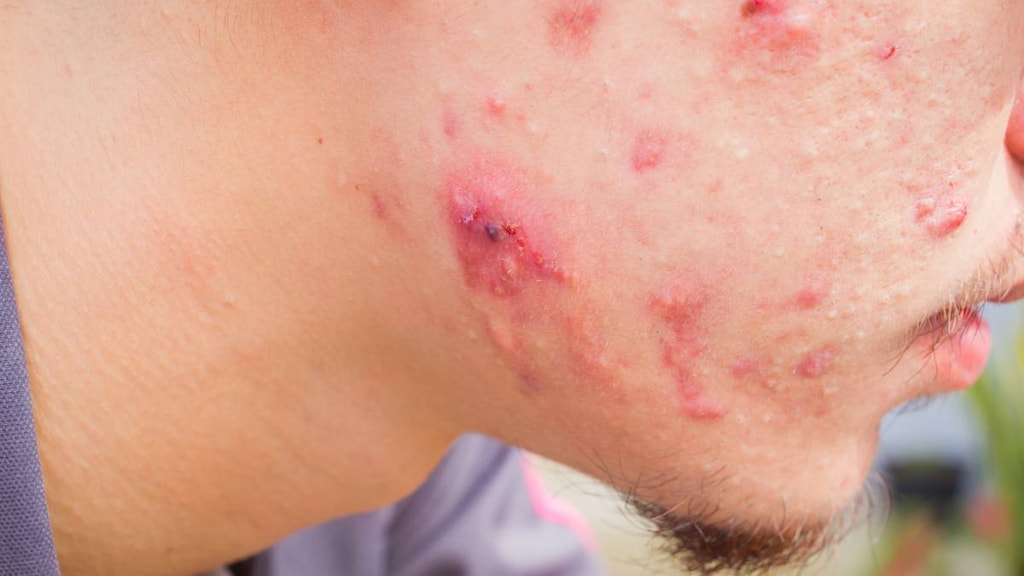Dosage Forms
Excipient information presented when available (limited, particularly for generics); consult specific product labeling.
Foam, External, as hydrochloride:
Amzeeq: 4% (30 g) [contains cetostearyl alcohol, coconut oil (copra/cocos nucifera oil), soybean oil]
Pharmacology
Mechanism of Action
The mechanism of action of minocycline for the treatment of acne is unknown.
Pharmacokinetics/Pharmacodynamics
Absorption
Topical: Steady-state reached after 6 days; pediatric patients (10 to <17 years of age) had a 2.4-fold higher Cmax and a 2.7-fold higher AUC than adult patients.
Use: Labeled Indications
Acne vulgaris: Topical treatment of inflammatory lesions of non-nodular moderate to severe acne vulgaris in adults and pediatric patients ≥9 years of age.
Note: The American Academy of Dermatology acne guidelines generally recommend topical antibiotics to be used in conjunction with other therapies (not as monotherapy) due to the risk of bacterial resistance (AAD [Zaenglein 2016]).
Contraindications
Hypersensitivity to tetracyclines or to any component of the formulation.
Dosage and Administration
Dosing: Adult
Acne vulgaris, moderate to severe:
Note: The American Academy of Dermatology acne guidelines generally recommend topical antibiotics to be used in conjunction with other therapies (not as monotherapy) due to the risk of bacterial resistance (AAD [Zaenglein 2016]).
Topical: Express a small (cherry sized) amount to fingertips and apply to acne-affected areas once daily; may repeat until all acne-affected areas are treated (Gold 2019; Raoof 2019).
Dosing: Geriatric
Refer to adult dosing.
Dosing: Pediatric
Acne vulgaris: Note: Due to emerging resistance patterns, topical antibiotics should not typically be used as monotherapy for the management of acne vulgaris (Eichenfield 2013; Zaenglein 2016).
Children ≥9 years and Adolescents: Topical: Foam: Apply small amount (eg, cherry sized) to affected area(s) once daily.
Administration
Topical: Not for oral, ophthalmic, or intravaginal use. Shake can well before use. Allow can to warm to room temperature before first use. Apply at approximately the same time each day ≥1 hour before bedtime. Do not bathe, shower, or swim for ≥1 hour after application. Avoid fire, flame, or smoking during or immediately following application.
Storage
Store at 2°C to 8°C (36°F to 46°F) until dispensed to the patient. Once dispensed, store at room temperature <25°C (77°F) for up to 90 days (do not refrigerate) Avoid fire, flame, or smoking during use. Do not puncture or incinerate container. Do not expose to heat or store at temperatures >49°C (120°F).
Drug Interactions
Aminolevulinic Acid (Systemic): Photosensitizing Agents may enhance the photosensitizing effect of Aminolevulinic Acid (Systemic). Avoid combination
Aminolevulinic Acid (Topical): Photosensitizing Agents may enhance the photosensitizing effect of Aminolevulinic Acid (Topical). Monitor therapy
Porfimer: Photosensitizing Agents may enhance the photosensitizing effect of Porfimer. Monitor therapy
Verteporfin: Photosensitizing Agents may enhance the photosensitizing effect of Verteporfin. Monitor therapy
Test Interactions
May cause interference with fluorescence test for urinary catecholamines (false elevations).
Adverse Reactions
>10%: Dermatologic: Erythema of skin (2% to 14%), hyperpigmentation (≤12%)
1% to 10%:
Central nervous system: Headache (3%)
Dermatologic: Xeroderma (≤7%), pruritus (≤5%), desquamation (≤3%)
Warnings/Precautions
Concerns related to adverse effects:
- Autoimmune syndromes: Lupus-like, hepatitis, and vasculitis autoimmune syndromes (including serum sickness [eg, fever, arthralgia, malaise]) have been reported with oral minocycline; immediately discontinue if symptoms occur.
- CNS effects: Lightheadedness, dizziness, and vertigo have been reported with oral minocycline; patients must be cautioned about performing tasks that require mental alertness (eg, operating machinery, driving). Symptoms may disappear with continued therapy and when the drug is discontinued.
- Hepatotoxicity: Serious liver injury, including irreversible drug-induced hepatitis and fulminant hepatic failure (sometimes fatal), have been reported with oral minocycline.
- Hypersensitivity/Skin reaction: Anaphylaxis, rash, erythema multiforme, Stevens Johnson syndrome or eosinophilia, fever, and organ failure including death (drug rash with eosinophilia and systemic symptoms [DRESS] syndrome), have been reported with oral minocycline; discontinue treatment immediately if DRESS syndrome is suspected.
- Intracranial hypertension: Intracranial hypertension (eg, headache, blurred vision, diplopia, vision loss, papilledema) has been associated with use of tetracyclines. Women of childbearing age who are overweight or have a history of intracranial hypertension are at greater risk. Concomitant use of isotretinoin (known to cause intracranial hypertension) and minocycline should be avoided. Intracranial hypertension typically resolves after discontinuation of treatment; however, permanent visual loss is possible. If visual symptoms develop during treatment, prompt ophthalmologic evaluation is warranted. Intracranial pressure can remain elevated for weeks after drug discontinuation; monitor patients until they stabilize.
- Metabolic effects: May be associated with increases in BUN secondary to antianabolic effects of tetracyclines.
- Photosensitivity: Photosensitivity has been reported with oral tetracyclines. Although not reported with topical minocycline, use skin protection, wear loose-fitting clothes that protect skin from sun exposure, and avoid or minimize exposure to natural or artificial sunlight. Discontinue use at first evidence of sunburn.
- Superinfection: Fungal or bacterial superinfection, including Clostridioides (formerly Clostridium) difficile–associated diarrhea (CDAD) and pseudomembranous colitis, has been reported with prolonged use of oral minocycline; CDAD has been observed >2 months post antibiotic treatment.
Special populations:
- Pediatric: Tissue hyperpigmentation, tooth enamel hypoplasia, or permanent tooth discoloration have been reported with oral tetracyclines, more common with long-term use, but observed with repeated, short courses. Use of tetracyclines should be avoided during tooth development (infancy and children ≤8 years of age) unless other drugs are not likely to be effective or are contraindicated.
- Pregnancy: Do not use during pregnancy. In addition to affecting tooth development, oral tetracycline use has been associated with delayed skeletal development and reduced bone growth.
Dosage form specific issues:
- Flammable contents: Foam contains flammable propellants. Avoid fire, flame, and smoking during and immediately following application.
Other warnings/precautions:
- Appropriate use: The American Academy of Dermatology acne guidelines generally recommend topical antibiotics to be used in conjunction with other therapies (not as monotherapy) due to the risk of bacterial resistance (AAD [Zaenglein 2016]).
Pregnancy
Pregnancy Considerations
Minocycline crosses the placenta and may cause fetal harm following oral administration. The amount of minocycline available systemically is less following topical application than with oral use.
Refer to the Minocycline (Systemic) monograph for additional information.
Patient Education
What is this drug used for?
- It is used to treat pimples (acne).
Frequently reported side effects of this drug
- Dry skin
- Redness
Other side effects of this drug: Talk with your doctor right away if you have any of these signs of:
- Kidney problems like not able to pass urine, blood in urine, change in amount of urine passed, or weight gain
- Lupus like rash on the cheeks or other body parts, sunburn easy, muscle or joint pain, chest pain or shortness of breath, or swelling in the arms or legs
- Loss of strength and energy
- Abnormal heartbeat
- Swelling
- Skin, nails, eyes, scar, teeth, or gum discoloration
- Sunburn
- Blindness
- Blurred vision
- Double vision
- Headache
- Clostridioides (formerly Clostridium) difficile-associated diarrhea like abdominal pain or cramps, severe diarrhea or watery stools, or bloody stools
- Liver problems like dark urine, fatigue, lack of appetite, nausea, abdominal pain, light-colored stools, vomiting, or yellow skin or eyes
- Stevens-Johnson syndrome/toxic epidermal necrolysis like red, swollen, blistered, or peeling skin (with or without fever); red or irritated eyes; or sores in mouth, throat, nose, or eyes
- Signs of a significant reaction like wheezing; chest tightness; fever; itching; bad cough; blue skin color; seizures; or swelling of face, lips, tongue, or throat.
Note: This is not a comprehensive list of all side effects. Talk to your doctor if you have questions.
Consumer Information Use and Disclaimer: This information should not be used to decide whether or not to take this medicine or any other medicine. Only the healthcare provider has the knowledge and training to decide which medicines are right for a specific patient. This information does not endorse any medicine as safe, effective, or approved for treating any patient or health condition. This is only a brief summary of general information about this medicine. It does NOT include all information about the possible uses, directions, warnings, precautions, interactions, adverse effects, or risks that may apply to this medicine. This information is not specific medical advice and does not replace information you receive from the healthcare provider. You must talk with the healthcare provider for complete information about the risks and benefits of using this medicine.




